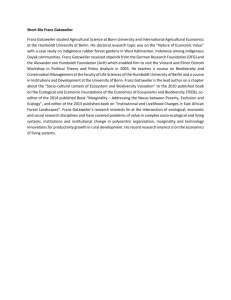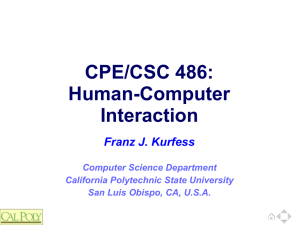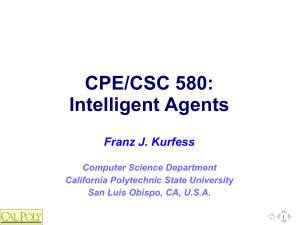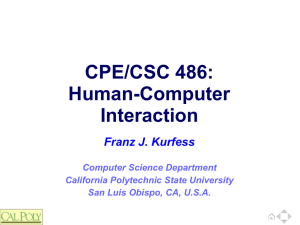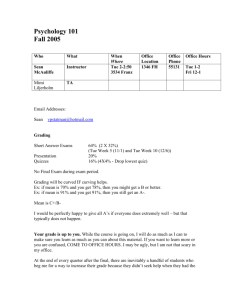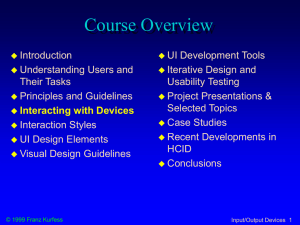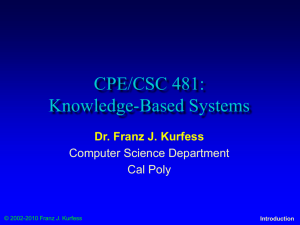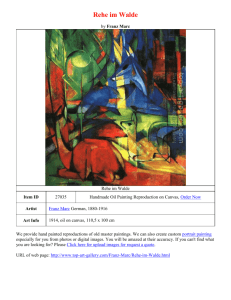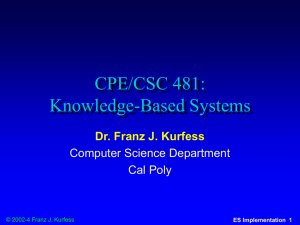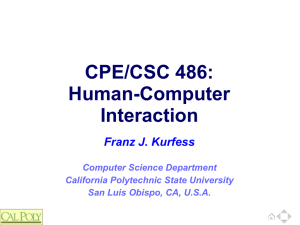CSC 480: Artificial Intelligence
advertisement
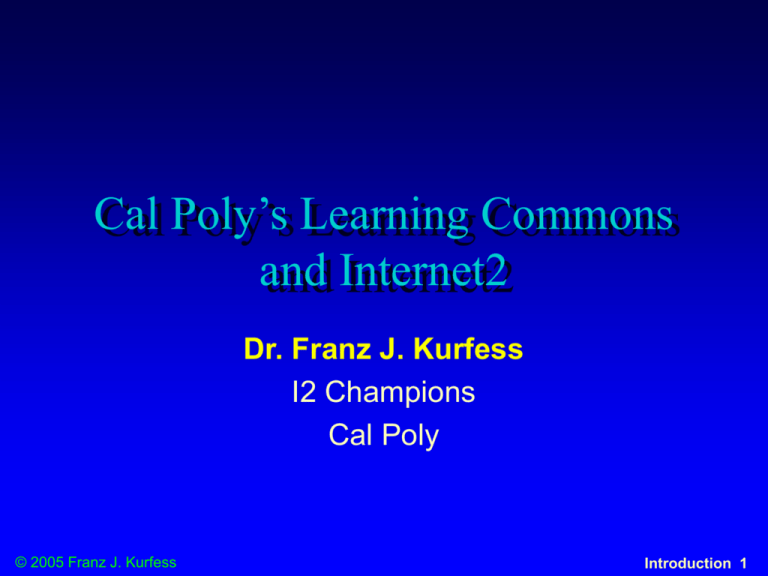
Cal Poly’s Learning Commons and Internet2 Dr. Franz J. Kurfess I2 Champions Cal Poly © 2005 Franz J. Kurfess Introduction 1 Overview Introduction Goals and Objectives Learning Space Internet2 and Learning Commons Conclusions and Outlook © 2005 Franz J. Kurfess Introduction 2 Introduction renovation of an under-utilized area in the library offered an opportunity to re-think the role of the library away from a repository of documents new teaching and learning resource that will have the capacity to foster creative and flexible interactions and learning relationships among students, professors, resources, and technology collaboration between library, ITS, faculty solicitation of input from students, faculty © 2005 Franz J. Kurfess Introduction 3 Goals create and implement a working model for a digital learning and teaching library learning communities interact in a rich physical and virtual environment supported by print, electronic, computing, and human resources explore and advance interdisciplinary learning and scholarship provide an infrastructure for collaboration and team work local and remote participants participatory design process involving students as the main client group © 2005 Franz J. Kurfess Introduction 4 Objectives offer research assistance and strategies enhancing student information competence provide flexible, multi-use space and services promote cross-disciplinary inquiry and discourse encourage academic and intellectual pursuits and partnerships promote collaborative projects and scholarship create a sense of community students, faculty, researchers, staff and community both contribute to and take from a knowledge creation and dissemination process © 2005 Franz J. Kurfess Introduction 5 Learning Space collaborative learning group study space student work displays rotating student art exhibits academically-oriented social space communities of practice events, activities, conferences, forums assistance with research & information competence ADA-Assistive technology & ergonomically compliant © 2005 Franz J. Kurfess Introduction 6 Phase I Learning Hub / Genius Bar Room 1: (216A) Smart Lab* (27 seats) Room 2: (216B) Cinema & Presentation Rehearsal Studio (Multimedia Production & Playback) Room 3: (217C) Smart (CAD) Lab* (25 seats) Room 4: (217D) Smart (CAD) Lab* (25 seats) Plotter Printers & Supplies Knowledge Managers Room 5: (35-202) Collaborative workspace for students & faculty) * Scheduled by University Scheduling © 2005 Franz J. Kurfess Introduction 7 Internet2 and Learning Commons infrastructure collaboration access to remote resources concentration of expertise © 2005 Franz J. Kurfess Introduction 8 Infrastructure ubiquitous high-bandwidth, low latency, defined QoS some rooms and areas are equipped for videoconferencing smart labs/classrooms collaboratory digital video production studio possible use of portable equipment and desktop equipment Web cams, small Polycom units facilities and transparent as infrastructure can be used as testbeds incorporation of capabilities in other classrooms, labs © 2005 Franz J. Kurfess Introduction 9 Collaboration group learning facilities with easy access to (remote) collaboration tools short-term availability of resources example software engineering teams collaborating with industrial or research partners marine biosciences, agriculture classes incorporating remote facilities e.g. Cal Poly, San Jose State, Lulea U. internships and similar situations Avila Pier, Swanton Ranch collaboration between classes at different institutions scenarios: students are temporarily away from campus access to guest speakers and domain experts attendance of on-line conferences, Web-cast presentations © 2005 Franz J. Kurfess Introduction 10 Access to Remote Resources Cal Swanton Ranch Avila Pier Cal Poly resources State electron microscope at Cal State East Bay UC UCSD supercomputing facilities other universities shared geospatial data repository research vessels for marine biology research institutions NASA, Lawrence Livermore Lab companies CISCO, HP © 2005 Franz J. Kurfess Introduction 11 Concentration of Expertise currently, many of our I2 activities are almost invisible only known to people directly involved I2 champions play an important role, but don’t have a lot of resources and only limited impact informal contacts between students IT people working in I2-related areas spatial proximity of related activities offers an opportunity for cross-pollination students, librarians, faculty, ITS staff e.g. Student Navigation Assistants at the genius bar © 2005 Franz J. Kurfess Introduction 12 Input Solicitation library ITS Center for Teaching and Learning also housed in the librarly building founding individual faculty members with specific interest Campus faculty Computing Committees AACC, IACC, SC3, College Computing Committees campus community other institutions with similar approaches Lulea University, Sweden other Cal State campuses Internet2 Commons © 2005 Franz J. Kurfess Introduction 13 Input from Students Cal Poly classes CSC 484-W05 User Interaction Design and Development CSC 581-S05 Knowledge Management San Jose State Library Lulea Sciences program University, Sweden social informatics graduate students © 2005 Franz J. Kurfess Introduction 14 Status phase I completed - April 05 renovation of the space used 3 smart labs moved to new space genius bar, digital video production studio Phase II under way Collaborative Learning Communities additional capabilities for labs, other spaces © 2005 Franz J. Kurfess Introduction 15 Conclusions Internet2 infrastructure is utilized to enhance capabilities of “Learning Commons” video conferencing, collaboration access to remote resources concentration of expertise and facilities will hopefully increase I2 visibility on campus easy access to facilities sharing of experiences between users staff and student assistants with practical experience © 2005 Franz J. Kurfess Introduction 16 Outlook a presentation and demonstration live from the Cal Poly “Learning Commons” at a future I2 meeting people behind the scenery student assistants first experiences © 2005 Franz J. Kurfess Introduction 17 © 2005 Franz J. Kurfess Introduction 18

